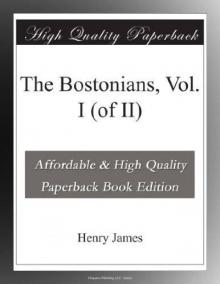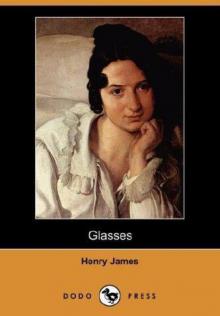- Home
- Henry James
Letters from the Palazzo Barbaro
Letters from the Palazzo Barbaro Read online
If it is profit that a man is after, he should become a merchant, and if he does the job of a bookseller then he should renounce the name of poet. Christ forbid that the business followed by such creatures should furnish a man of spirit with his occupation.
Every year I spend a fortune, and so it would be a fine thing if I followed the example of the gambler who placed a bet of a hundred ducats and then beat his wife for not filling the lamps with the cheapest oil.
So print my letters carefully, on good parchment, and that’s the only recompense I want. In this way bit by bit you will be the heir to all my talent may produce.
ARETINO
from a letter dated 22nd June 1537, sent from Venice
HENRY JAMES
LETTERS
FROM THE
PALAZZO
BARBARO
Edited by Rosella Mamoli Zorzi
PUSHKIN PRESS
LONDON
ACKNOWLEDGEMENTS
I would like to dedicate the English, revised version of this book to the memory of Leon Edel, without whose encouragement I would never have proceeded along the path of Jamesian studies. And my gratitude to Alexander R. James, who has generously given his permission for the publication of James’s work for this book, and on previous occasions.
I would like to thank the Directors of the following Institutions for their permissions to publish these letters, for the joy of working in their libraries, and their staff for their helpfulness: the Houghton Library of Harvard University, the Dartmouth College Library, the C. W. Barrett Library of the University of Virginia, the Isabella Stewart Gardner Museum, the Ashmolean Museum of Oxford, and the Biblioteca Nazionale Marciana in Venice.
Finally, my gratitude for initiating my Jamesian interests goes to Sergio Perosa (Ca’ Foscari University), and to Alide Cagidemetrio (University of Udine) and Werner Sollors (Harvard University) for their intelligent and affectionate help and advice.
Patricia Curtis Viganò and Carlo Viganò—and the wide-open marble arms of their Palazzo Barbaro—were a constant source of encouragement for which I am truly thankful.
I would also like to thank Marina Coslovi for her help in preparing the text.
Rosella Mamoli Zorzi
June 1998
CONTENTS
Title Page
Acknowledgements
Foreword by Leon Edel
Introduction by Rosella Mamoli Zorzi
Letters by Henry James
Letters by the Curtises
Notes by Ariana Curtis
Notes by Patricia Curtis Viganò
Index
Also Available from Pushkin Press
About the Publisher
Copyright
Façade, Palazzo Barbaro
FOREWORD
BY LEON EDEL
This book celebrates a single palace in Venice—the Palazzo Barbaro, whose steps are washed by the Grand Canal. A modest, thick-walled palace with two striking rows of Gothic windows, it was built in the fifteenth century and survived the turbulent years of the wars with the Turks and the fatal Venetian conquest of Lombardy. In the quietude of Venice’s decline, it became—in the 1880s—the residence of American expatriates, children of a new empire of commerce. Perhaps Venice seemed to them to have some of the uniqueness they imparted to Boston, for the Barbaro might have been called in the late nineteenth century an outpost of Boston. It was purchased by two proper Bostonians, Daniel Curtis and his wife Ariana and at times they rented it to another Bostonian, the bejewelled and queenly Isabella Stewart Gardner, who in the end would build her own Venetian palace, Fenway Court, in her home city.
An entire book might be written about the relations between Venice and its Americans, but Rosella Mamoli Zorzi has chosen to offer us a modest gathering-in of certain letters written by members of the trans-Atlantic society who were joined by certain British figures in the high-ceilinged drawing room of the Barbaro’s piano nobile. Here Robert Browning, friend of another American expatriate in Venice, Mrs Bronson, came for tea and chatted about commonplace things; here John Addington Symonds, the historian of the Italian renaissance, a Victorian with a “secret life” and his friend Horatio Brown, frequently dined. And here Henry James, the American novelist of international moeurs, sometimes came for long visits. A compulsive letter-writer, he is at the very centre of Rosella Zorzi’s anthology, for he provides vivid documentation of that particular society.
James came to Venice at first simply as a tourist. Returning in the 1880s he took possession of the city as he had of the Old World and in this instance in language uncommonly erotic for a man of his reticence—“you desire to embrace it, to caress it, to possess it.” From that time on Venice became one of his regular way-stations on the Continent. At one moment he even dreamed of finding a pied-à-terre such as he gave to his character Merton Densher near the Rialto. However he found something better. The Palazzo Barbaro and its high life-style was always open to him. The Curtises liked his elegance, and his grand way of saying things. He, in turn, fell in with the idiosyncrasies of Daniel Curtis, with his twice-told anecdotes, his exploits as a gardener in a city that has little land for gardening, and his irascible criticisms of their mutual United States. James in particular liked the Barbaro itself—its cool high rooms, the cushioned seats inside the Gothic windows and the balcony from which he watched the traffic of the Grand Canal and the doings of neighbours in the shabby row of palaces across the way. He had feelings of grandeur, princely feelings, as he mounted the massive staircase in the Barbaro’s inner courtyard. That allowed him direct access to the piano nobile.
He also stayed at the Barbaro when Isabella Gardner held court in it during her summer rentals. Life in the Barbaro was American at its most sophisticated, even if touched by certain provincialisms. But then, Venice itself, shorn of imperium, seemed a provincial city, an adorable place outside and beyond the rest of the world. For James, the Piazza San Marco was “the drawing-room of Europe” and he tells us that the great square with its wheeling and floating pigeons had witnessed “more of the joy of life than in any equal area in Europe.” We pause over this, for territorially the Square would be less than a pinhead on the map of Europe. Nevertheless the joy he spoke of must have been intense, at least for him—and it certainly was visible in the faces of tourists who filled the piazza every day and night.
This was the public life of Venice. Novelists like James, however, are always in search of private lives, or as he put it “we peep at most into two or three of the chambers of their hospitality.” Still, he could endow his heroine in The Wings of the Dove with his own examination of the ceiling in the Barbaro library where on one occasion Isabella put in a bed for him, all the other guest rooms being occupied. We know he greatly enjoyed this experience for he dwells in his novel on the arabesques, medallions and the play of light “on the stirred sea-water, flickering up through open windows” and relishes “the nest of white cherubs set in their great moulded and figured concavity.” In one letter to Isabella he remembers the pink chairs and the yellow sofa and a glimpse of her queenly self in a gauze dressing gown on a blue chair.
We are committed to verbal pictures. We remind ourselves however that John Singer Sargent was a friend of the Curtises and he painted them under the great chandeliers in the drawing-room, Daniel and Ariana, and their son Ralph and his wife, a fine painting, highly documentary, of 1899. Another painter, during one of Isabella’s sojourns, Anders Zorn, from Sweden, has left us a portrait of the lady floating in through the curtains of one of the windows.
Such is the testimony of brush and pen to what James called “the poetry of the thing outlived and lost and gone.” He finished The Aspern Papers in
the Barbaro in 1887; and during another visit wrote A London Life at an oriental desk probably plundered centuries before in the east.
This volume now becomes a part of our testimony. However we cannot recover the talk or the nights when hundreds of candles were lit and the music of hired musicians or visiting celebrities could be heard as it floated through the delicately-shaped windows over the water. Royalty too came to the Barbaro: we can instance, among visits from the north, Queen Victoria’s daughter, the one who briefly was Empress of Germany, adorning the drawing-room, surrounded by awe and honor. But there is in this volume also a “peep” at Henry James himself through the eyes of the young Ralph Curtis. In one of his letters he describes the novelist as haunted by “the printer’s devil.” And then he adds “what a pity he knew no other.” It is an observation for biographers and their meditations. Rosella Zorzi’s anthology sets us dreaming of the beautiful preserved city, its Grand Canal, the bridges and footways, and the ghosts that now exist only in old documents as Venice, on its treacherous sea, is translated into enduring literature.
Early twentieth century view of the Palazzo Barbaro
INTRODUCTION
BY ROSELLA MAMOLI ZORZI
There is a palazzo, on the Grand Canal, quite close to the Accademia Bridge, which looks over the vast ribbon of the Grand Canal where it widens into the Bacino of St. Mark’s. If you lean out just a little from the balcony of its Gothic windows, you will see the magnificent structure of the Salute church across the water, near the Punta della Dogana. Then your eyes, coming back along the Canal, will take in the façades of the Gothic Palazzo Semitecolo, the Wolkoff, the multicoloured and now infamous Dario, the unfinished majesty of the Venier dei Leoni (now the Peggy Guggenheim Museum), the modest Casa Biondetti—once the home of painter Rosalba Carriera—the imposing Gothic façade of Palazzo Da Mula, and then, beyond the Canal of San Vio, the façades of Ca’ Loredan and Contarini dal Zaffo, stopping in front of the Accademia bridge.
Your gaze, turning into the interior of the palace after being dazzled by the view outside of the Grand Canal, will not find a rest: the glimmering splendour of the water and the bright colours of the marble façades are replicated in the glory of the gilded stuccoes, of the paintings, of the mother-of-pearl floors. The dazzle will only relent in the slightly damp penumbra of the courtyard, when you descend the steep, open staircase, or in the shadowy light which filters through the long ground-floor passageway leading to the palazzo’s water gate. In that passageway a grounded gondola, with its black felze still there to protect its passengers from wind and rain, seems to be waiting for a Domenico or an Angelo to row it back into its natural element, the water of the Grand Canal.
This palace, Palazzo Barbaro, is only one of the many patrician houses that testify to the former greatness of Venetian families and of a civilization tracing back many generations. It is also one of the many palaces that were sold after the fall of the Venetian Republic in 1797 and which fell into the greedy hands of speculators, who did not hesitate to sell off and disperse the memories of centuries of history, the family archives, paintings, art objects, antique furniture. The very walls of these palaces were plundered: the stucco work was chiselled off, the frescoes were torn down, the inlaid wooden doors were lifted off their iron hinges; whole buildings were razed and the bricks and stones were used as building materials.
Until 1797 the Palazzo Barbaro had witnessed centuries of splendour. In the fifteenth century it had been the meeting point for some of the most illustrious representatives of Renaissance humanism. These scholars had been drawn to the house by the bright mind of Almorò Barbaro, who meditated on the chapters of Aristotle which he would expound, in the original Greek, to his disciples from the University of Padua while walking to and fro in his grand salon. To this house came Poliziano1, to receive a Greek vase from the hands of Almorò’s father, Zaccaria, the Procuratore of San Marco, an illustrious politician and the son of the first Venetian humanist, Francesco. Zaccaria was the Barbaro who, around 1460, had originally bought the palace that would carry his family’s name for so many centuries.
From that date the salons of the palace echoed with debates regarding the noblest themes of culture and the most important political issues.
In the 1540s, in these rooms, Daniele, the ambassador of the Venetian Republic to England, later the Patriarch Elect of Aquileia, gathered the founders of modern mathematics and architecture. A friend and a patron of Palladio and Scamozzi, Daniele obtained for them the great public commissions of Venice. His own translation of, and commentary on, Vitruvius’s Treaty on Architecture was extremely influential. In the same period, his brother Marc’Antonio devoted himself to diplomacy and politics, becoming a Procuratore of San Marco. Splendid and cultured, he shared and supported his brother’s choices, and with him he decided to build the famous Villa of Maser, designed by Palladio, with frescoes by Veronese. Half a century later, another Barbaro, Antonio, an opponent of the great general Francesco Morosini, had the baroque church of Santa Maria del Giglio built to celebrate the family.
Voices full of wisdom, knowledge, and power resounded within the damask-lined walls of the palace, against its Istria stone balconies, on its terrazzo floors. The century of baroque splendour brought sumptuous embellishments to the house, clear signs of the great power of the family. At the end of the seventeenth century, the architect Antonio Gaspari was commissioned to build the great ballroom, linking two adjacent palaces. Artists in stucco work from Ticino were called to decorate the ballroom walls with shells and putti and ribbons and gilded triumphs—just as in the Albrizzi and Sagredo palaces or at the Scuola dei Carmini—while great masters were entrusted with the paintings and frescoes. Giambattista Tiepolo, Gian Battista Piazzetta, Sebastiano Ricci and Antonio Balestra were among them. The perfect taste of the Barbaros chose the best artists of each generation.2
Then, after all this glory of culture, politics, and art, ruin descended on the palazzo. After 1861, the palace was sold several times, into the clutches of unscrupulous antique dealers. Among these some tried to tear down the stucco work to sell it to the London South Kensington Museum (now the Victoria & Albert Museum), but the palace did not allow them to do this: it was simply impossible to detach the stucco work. The greed of one dealer saved the great doors: he thought the 17,000 lire offered by Lady Alford too low a price.3 But the Tiepolos were sold, the courtyard well-head removed, hoisted onto a big black boat, and taken away; the ceiling was partly covered with bitumen, because the people who had moved into the palace did not like being “spied” upon by the allegorical figures flying above them in the painted skies4.
The ruin of the palace seemed unavoidable. On a December afternoon in 1885, “buyers and sellers, lawyers and witnesses” met to draw up a sale contract. Palazzo Barbaro, then the property of “Cav. Dott. Cesare Musatti” through his wife, was sold to an American couple, Daniel Sargent Curtis and Ariana Wormeley Curtis.
The palace was saved.
If Daniel and Ariana were certain they had made a good investment, for the palace it was the height of good fortune to end up in the hands of a couple who loved it, restored it, and respected it. They were determined not to redo it completely as was the custom with those nineteenth-century owners and architects against whom Ruskin had fought his battles, together with Alvise Piero Zorzi in Venice.5 The Curtises transformed the palace again and made it into a centre of elegant social life, but they also invited artists, writers, poets, painters, and musicians. These artists caught and expressed the essence of the Barbaro, in paintings and novels, building the Barbaro of their imagination, of pigments and words.
The Barbaro salons with their frescoes and paintings and stucco work fascinated such painters as John Singer Sargent, who portrayed the Curtises, with their son Ralph, a painter himself, and his wife Lisa, in the splendour of the ballroom, in the painting entitled An Interior in Venice (1899). The palace also enchanted Anders Zorn, who portrayed Isabella Stewart Gardner, the creator of F
enway Court at Boston and who occasionally rented the palace, as she stepped in from the palazzo balcony, against the nocturnal background of the Grand Canal lit up by fireworks. Other painters, such as Walter Gay, or Ralph Latimer, offered other interpretations: Gay painted the ballroom, with its paintings, stucco work, sofas, chairs and tables, without any human figure in it, as if the beauty of the place was enough. Latimer, Ralph Curtis’s cousin, painted several rooms of the Barbaro.6
JAMES’S ARRIVAL IN VENICE
But the artist who more than anyone else filtered through his imagination the enchantment of the “marble halls” of the Barbaro was the American writer, Henry James (1843–1916). After a first visit in 1887 he was often a guest of the Curtises or of Isabella Stewart Gardner.
The impressions that James had of the Barbaro—over a period of several years—can be traced in his letters, which, although they are not entirely devoted to this topic, bear witness to the power of the Barbaro over the writer’s imagination.
In James’s letters7 to Catherine Walsh (VII), Grace Norton (IX), and Ariana Curtis (XIV, XV) “the beautiful empty Barbaro”, “all marbles and frescoes and portraits of the Doges”, starts to exercise a charm that “sinks into your spirit only as you go on living there, seeing it in all its hours and phases” (III, 195). These words appear, almost identical, in his essay The Grand Canal (1892),—where the name of the palace is not given, out of respect for the Curtises’ privacy—but where the Barbaro is clearly recognizable with its “painted chambers that still echo with one of the historic names”:

 The American
The American The Wings of the Dove, Volume 1 of 2
The Wings of the Dove, Volume 1 of 2 Frost at Midnight
Frost at Midnight Morning Frost
Morning Frost The Portrait of a Lady — Volume 1
The Portrait of a Lady — Volume 1 Fatal Frost
Fatal Frost The Europeans
The Europeans The New York Stories of Henry James
The New York Stories of Henry James Great Short Novels of Henry James
Great Short Novels of Henry James Washington Square
Washington Square The Portrait of a Lady — Volume 2
The Portrait of a Lady — Volume 2 The Ambassadors
The Ambassadors The Wings of the Dove
The Wings of the Dove The Princess Casamassima (Classics)
The Princess Casamassima (Classics) The Coxon Fund
The Coxon Fund First Frost
First Frost Henry James
Henry James The Daily Henry James
The Daily Henry James Travels With Henry James
Travels With Henry James The Reverberator: A Novel
The Reverberator: A Novel What Maisie Knew (Henry James Collection)
What Maisie Knew (Henry James Collection) The Outcry
The Outcry The Marriages
The Marriages The Wings of the Dove, Volume 2
The Wings of the Dove, Volume 2 The Bostonians, Vol. I
The Bostonians, Vol. I The Outcry: -1911
The Outcry: -1911 The Complete Works of Henry James
The Complete Works of Henry James Letters from the Palazzo Barbaro
Letters from the Palazzo Barbaro The Pupil
The Pupil The Bostonians, Vol. II
The Bostonians, Vol. II Pandora
Pandora Glasses
Glasses The Princess Casamassima
The Princess Casamassima What Maisie Knew
What Maisie Knew The Reverberator
The Reverberator The Golden Bowl - Complete
The Golden Bowl - Complete Confidence
Confidence Wings of the Dove (Barnes & Noble Classics Series)
Wings of the Dove (Barnes & Noble Classics Series) The Spoils of Poynton
The Spoils of Poynton